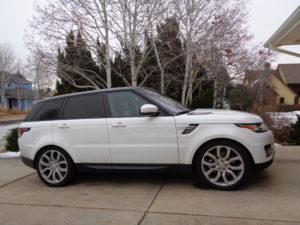
I took one final drive, short though it was, in the 2017 Range Rover Sport during a Monday morning snowstorm, an hour or so before its scheduled departure from my possession.
I love to drive the Range Rovers and could have enjoyed this one for another week, if it had been offered. To drive one is to like it, and the exterior styling of the Range Rover Sport is about as good as it gets with a luxury midsize SUV.
I was asked more than once whether the one I drove was a Land Rover or a Range Rover. It is, I guess, both, for Land Rover is the company name and Range Rover the model name.
I’d never call it a Land Rover Range Rover. The full-size model is the Range Rover, then there is the midsize Range Rover Sport, which I drove, and the compact Range Rover Evoque.
Two other models were passed over by the Range Rover name, so they go as the Land Rover LR4 and the Land Rover Discovery Sport.
Confusing as it is, it started back in 1970 when the British company Land Rover introduced the Range Rover 4X4 utility vehicle in Europe. The big Range Rover reached the U.S. market in 1987, celebrating this year its 30th anniversary. Land Rover products continue to be designed, engineered and built in England. The firm, though, along with Jaguar is owned by Tata Motors of India.
That’s the English lesson for today.
Back to the Range Rover Sport, which competes against other luxury midsize SUVs, such as Porsche Cayenne, Volvo XC90, Lincoln MKX, Cadillac XT5, Lexus GX, BMW X5 and Audi Q7. These models offer more seating, larger cargo area, upgraded interiors and better performance than the popular compact SUV/crossovers.
A 340-horsepower, supercharged 3.0-liter V-6 with 332 lb.-ft. of torque is mated to an 8-speed automatic transmission, giving the Range Rover Sport smooth-shifting and outstanding acceleration. Its paddle shifters lend quickness to the operation and its four-wheel-drive setup is enhanced with all-terrain control for which Range Rovers have long been noted.
The Sport rides on 22-inch wheels, shod with Continental CrossContact 275/40R22 tires. It delivered an overall average of 18.9 miles per gallon of premium fuel; EPA estimate is 17-23.
Climb into the cabin and enjoy the perforated white leather seats with dark piping, and the interior trim of dark gray oak wood and satin brushed aluminum. Seating position is high with lots of glass and vision is very good, except for a bit of blockage by large rear-seat headrests.
I found the key pod not proficient at locking and unlocking the doors every time, and Jan took issue with difficulty of the touchscreen climate control in tempering down heat-ducts flow of warm air.
The $86,916 sticker price covered parallel and perpendicular park assist, heated and cooled front seats, automatic high beams, soft-door closing, surround cameras, lane-departure warning, panoramic roof, Meridian premium audio, navigation, head-up display, power tailgate with hands-free open and close.
Land Rovers through the years have appealed to drivers who desire to head out regardless of weather or road conditions. A young woman neighbor of ours for several years has gotten around regularly with an older Discovery. The sturdy, upright four-door appears to be the most indestructible vehicle in this part of the city.